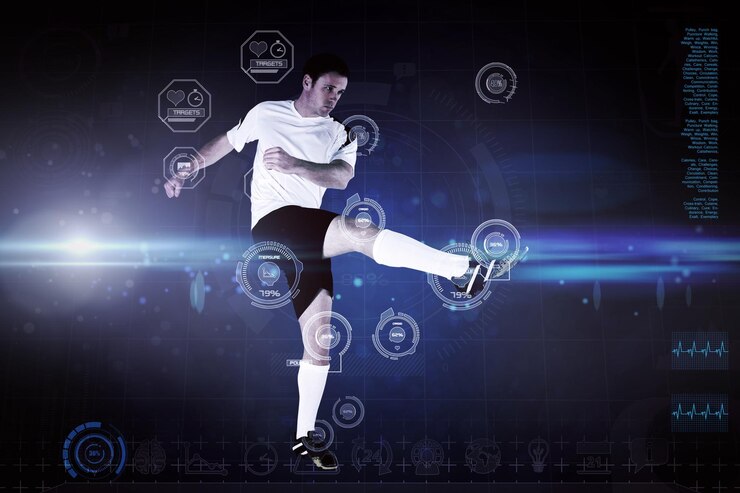Wearable technology has revolutionized the way athletes train, compete, and recover, providing unprecedented insights into performance and health metrics. From fitness trackers to smart clothing, these devices offer a wealth of data that can help athletes optimize their routines and achieve peak performance. This article explores the various types of wearable technology available to athletes, their benefits, and the future trends in this rapidly evolving field.
Types of Wearable Technology for Athletes
Fitness Trackers and Smartwatches
Fitness trackers and smartwatches are among the most popular wearables for athletes. These devices monitor a range of metrics, including heart rate, steps taken, calories burned, and sleep patterns. Advanced models also offer GPS tracking, which is particularly useful for runners and cyclists to map their routes and analyze their pace and distance.
Popular Devices:
- Fitbit Charge: Known for its comprehensive health tracking features.
- Apple Watch: Offers a wide array of fitness and health apps, along with seamless integration with other Apple products.
- Garmin Forerunner: Preferred by runners and triathletes for its advanced GPS capabilities and training metrics.
Heart Rate Monitors
Heart rate monitors provide real-time data on an athlete’s heart rate during exercise, which is crucial for maintaining the right intensity levels in training. These devices can be worn on the wrist, chest, or arm, and they help athletes avoid overtraining and track improvements in cardiovascular fitness.
Popular Devices:
- Polar H10: A chest strap monitor known for its accuracy.
- Wahoo TICKR: Offers Bluetooth and ANT+ connectivity for compatibility with various devices and fitness apps.
Smart Clothing
Smart clothing integrates sensors into the fabric to monitor various physiological metrics. This can include heart rate, muscle activity, and body temperature. Smart clothing is particularly useful for providing a more comprehensive and unobtrusive way to gather data during training sessions.
Popular Products:
- Hexoskin: Smart shirts that monitor heart rate, breathing rate, and activity levels.
- Athos: Compression clothing that tracks muscle activity and balance.
GPS Trackers
GPS trackers are essential for athletes involved in outdoor sports like running, cycling, and hiking. These devices not only track location but also provide data on speed, distance, and elevation. They are invaluable for planning and analyzing training sessions and races.
Popular Devices:
- Garmin Edge: Preferred by cyclists for its detailed route mapping and performance metrics.
- Suunto 9: Known for its robust GPS tracking and long battery life.
Wearable Hydration Monitors
Hydration is critical for athletic performance, and wearable hydration monitors help athletes maintain optimal fluid levels. These devices track sweat levels and provide real-time feedback on hydration needs, reducing the risk of dehydration.
Popular Devices:
- LVL Hydration Monitor: Measures hydration, heart rate, and activity levels.
Benefits of Wearable Technology for Athletes
Performance Optimization
Wearable technology allows athletes to gather precise data on their performance, enabling them to tailor their training programs to their specific needs. By monitoring metrics like heart rate, pace, and power output, athletes can adjust their intensity to maximize performance and avoid overtraining.
Injury Prevention and Recovery
Wearable devices can help prevent injuries by monitoring workload and detecting signs of fatigue. For instance, smart insoles can track running form and identify irregularities that might lead to injuries. Additionally, wearables can assist in recovery by monitoring sleep quality and recovery metrics, ensuring athletes get the rest they need to heal and perform at their best.
Health Monitoring
Continuous monitoring of vital signs such as heart rate and blood oxygen levels can alert athletes to potential health issues before they become serious. This is particularly important for athletes with known health conditions who need to keep their parameters within safe ranges.
Data-Driven Decisions
The data collected by wearables provides valuable insights that can be used to make informed decisions about training and competition. Coaches and sports scientists can analyze this data to fine-tune training plans, nutritional strategies, and recovery protocols.
Future Trends in Wearable Technology for Athletes
Advanced Biometrics
Future wearables will likely offer even more advanced biometric measurements, including blood glucose levels, lactate thresholds, and hormonal balances. These metrics will provide deeper insights into an athlete’s physiological state and help optimize training and performance.
AI and Machine Learning Integration
The integration of AI and machine learning into wearable technology will enhance the ability to interpret complex data sets and provide personalized recommendations. AI algorithms can analyze trends and predict potential injuries, allowing for proactive measures to be taken.
Enhanced Connectivity and Integration
Wearables will continue to become more interconnected with other devices and platforms, offering seamless data integration across multiple aspects of an athlete’s life. This holistic approach will provide a more comprehensive understanding of performance and health.
Non-Invasive Monitoring
Advancements in sensor technology will lead to more non-invasive wearables that can monitor internal biomarkers without the need for intrusive methods. This will improve comfort and usability, encouraging more athletes to adopt wearable technology.
Sustainability and Durability
As wearables become more ubiquitous, there will be a greater focus on sustainability and durability. Future devices will likely be designed with eco-friendly materials and longer lifespans, reducing their environmental impact.
Wearable Technology for Athletes: Revolutionizing Performance and Well-being
In the dynamic world of sports, wearable technology is emerging as a game-changer, providing athletes with unprecedented insights into their performance and health.
From cutting-edge smart garments to sophisticated hydration monitors, these innovations are transforming how athletes train, compete, and recover. This article takes a unique look at wearable technology for athletes, examining its diverse applications, benefits, and future possibilities.
The Spectrum of Wearable Technology
Smart Garments: The Fabric of Future Performance
Smart garments are redefining athletic wear by integrating advanced sensors directly into the fabric. These wearables can monitor physiological parameters like muscle activity, heart rate, and respiratory rate without the need for separate devices.
Cutting-Edge Examples:
- Nadi X Yoga Pants: Equipped with sensors and haptic feedback to guide yoga practitioners through poses, ensuring proper form and reducing injury risk.
- Ralph Lauren’s PoloTech Shirt: Measures heart rate, breathing depth, and energy output, providing a comprehensive overview of an athlete’s physical state during workouts.
Neuro-Feedback Devices: Mind Over Matter
Neuro-feedback devices offer athletes the ability to monitor and optimize their brain activity. These wearables can help enhance focus, reduce stress, and improve mental resilience – key factors in high-performance sports.
Innovative Devices:
- Muse Headband: Uses EEG sensors to provide real-time feedback on brain activity, helping athletes practice mindfulness and improve mental clarity.
- Halo Sport: Employs neurostimulation to prime the brain for physical training, potentially enhancing muscle memory and skill acquisition.
Hydration and Nutrition Trackers: Fueling Performance
Staying hydrated and maintaining proper nutrition are critical for athletic performance. Wearable hydration and nutrition trackers monitor fluid levels, nutrient intake, and metabolic rate, ensuring athletes can optimize their diet and hydration strategies.
Pioneering Technologies:
- Nix Hydration Biosensor: A single-use biosensor that measures sweat composition to provide real-time hydration data, helping athletes maintain optimal fluid levels.
- Lumen Metabolism Tracker: Analyzes breath to determine whether the body is burning fats or carbs, offering personalized nutrition recommendations.
Recovery and Rehabilitation Wearables: The Road to Recovery
Recovery and rehabilitation are essential components of an athlete’s routine. Wearable devices designed for these purposes can monitor recovery metrics and provide therapeutic interventions to expedite the healing process.
Leading-Edge Solutions:
- NormaTec PULSE 2.0: Compression therapy system that enhances blood flow and reduces muscle soreness, aiding in faster recovery.
- TheraBand Kinesiology Tape: Embedded with microchips to track movement and muscle usage, providing data that can guide rehabilitation exercises.
Transformative Benefits of Wearable Technology
Personalized Training Programs
Wearables provide detailed data that allows for highly personalized training programs. Athletes can tailor their workouts based on real-time feedback, ensuring they are training at the optimal intensity and avoiding overtraining.
Proactive Health Monitoring
Continuous monitoring of vital signs and physiological parameters helps in early detection of potential health issues. Wearables can alert athletes and their coaches to abnormal patterns, allowing for timely interventions and reducing the risk of serious conditions.
Enhanced Mental Performance
Neuro-feedback wearables empower athletes to harness the power of their minds. By improving focus, reducing anxiety, and enhancing mental resilience, these devices can give athletes a psychological edge in competition.
Optimized Nutrition and Hydration
Accurate monitoring of hydration and nutritional status ensures athletes are fueling their bodies correctly. This optimization can enhance energy levels, improve performance, and aid in quicker recovery.
Accelerated Recovery and Injury Prevention
Recovery wearables provide therapeutic interventions that accelerate healing and reduce downtime. Additionally, by monitoring biomechanics and muscle usage, these devices can help prevent injuries by highlighting improper techniques or overuse.
The Future of Wearable Technology in Sports
Integration with Artificial Intelligence (AI)
Future wearables will increasingly integrate with AI to provide more sophisticated analysis and personalized recommendations. AI can analyze large datasets to identify patterns and make predictive models that enhance training and recovery plans.
Multi-Functional Wearables
The next generation of wearables will combine multiple functions into a single device. Imagine a smart shirt that tracks cardiovascular metrics, monitors hydration levels, and provides neuro-feedback, all in one garment.
Eco-Friendly and Sustainable Designs
As awareness of environmental impact grows, there will be a push towards eco-friendly and sustainable wearable technologies. This includes using recyclable materials and designing devices with a longer lifespan to reduce waste.
Augmented Reality (AR) Integration
AR-enabled wearables could provide athletes with real-time data overlays during training or competition. For example, a runner could see their pace and heart rate displayed directly in their field of vision, allowing for instant adjustments.
Greater Accessibility and Affordability
As technology advances and production costs decrease, wearable technology will become more accessible and affordable for athletes at all levels. This democratization will allow more people to benefit from the insights and advantages these devices offer.
Wearable technology is transforming the landscape of sports, offering athletes unprecedented access to data and insights that can enhance performance and health.
From smart garments and neuro-feedback devices to hydration trackers and recovery wearables, the possibilities are vast and continually expanding.
As we look to the future, the integration of AI, sustainability, and multifunctionality will further elevate the impact of wearables, ensuring that athletes can train smarter, compete harder, and recover faster. Embracing these innovations will be key for those looking to stay ahead in the competitive world of sports.
Wearable technology has become an integral part of modern athletics, offering athletes unparalleled insights into their performance and health.
From fitness trackers to smart clothing, these devices provide valuable data that can enhance training, prevent injuries, and monitor overall well-being.
As technology continues to advance, the potential for wearable technology in sports is limitless, promising even more sophisticated tools to help athletes achieve their goals. Embracing these innovations will be key for athletes and coaches looking to stay at the forefront of sports performance and health management.









Leave a Reply